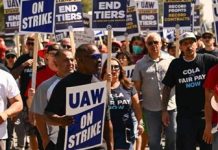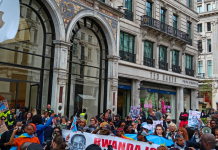Carillion, momentarily the biggest and brightest star in the UK construction firmament, has crashed and burned. Brian Parkin explains that the company wasn’t an exception, but all too typical of the spiv business model the dominates UK construction.

A company ranked with a turnover of over £5 billion in 2017-17, which has enjoyed “most favoured” government project bidder, has seen its share price tumble from a heady gold plated 300p in June 2016 to just 14p at close of trading on Friday 12 January and to zero now. The collapse was a long time coming – and the result of a business model built on low capitalisation, cut-throat cost cutting, rigged contract bidding and the most diabolical employment practices imaginable, up to and including union-busting and blacklisting union activists.
Carillion: a Mafia marriage
Carillion was born out of the boom of the early 2000’s, a boom characterised by easy credit and zero regulation. Four elements combined to provide optimum conditions for a construction sector boom: earlier Tory privatisations; the loosening of financial trading and company regulations; a property speculation frenzy in the London area; and the conversion of prudent public investment into PFI contracts on the never-never.
However, this “Blair boom” of speculative property development also involved a number of risks. If delays occurred, investors might seek punitive, or even ruinous, damages. Or the overall project value and entailed investment could be too big for a single company to bear.
And so there arose the Joint Venture company – legal entities big enough to make the required investment, from which no incurred penalties could attach to the parent companies. For example, on the Crossrail project, where many contracts were in excess of £800 million, three companies came together to form BFK, which is constructing tunnels and stations – civil engineering company BAM, Spanish transport multinational Ferrovial and property group Kier. In the case of Carillion, three major construction companies merged most of their core activities under a single registered company name.
These companies were characterised by high finance at the top and union-busting at the bottom. The newly-created BFK sacked Unite steward Frank Morris at the earliest stages of the project, for example. The three companies that created Carillion combined links to the Tory party with abuses against their workers.
- Tarmac, a long established civil engineering contractor for motorways and bridges, was a notorious black-lister – that is, a company which kept records of trade union activists and refused to employ them. Tarmac was cited in the High Court hearings in 2016 and was forced to pay undisclosed compensation to its victims. The company also had a long history of Tory party donations.
- Mowlem, another company that had risen high on the back of the 1970’s public construction boom, was also another known blacklisting company – and, like Tarmac, was entirely engaged in construction.
- Sir Alfred McAlpine, the third partner-to-be in the Carillion merger, was a traditional construction operation on the surface, but an extensive property development operation also ensured a healthy whack of revenues. The firm was by far the most notorious UK construction company in the eyes of many union activists, earning a reputation for hire and fire and blacklisting, and for its numerous “lump” (essentially illegal cash-in-hand) workforce known as “McAlpine’s Fusiliers”. Sir Alfred was however an aristocrat in comparison with many construction bosses. During the 1970’s company director Alistair McAlpine had been the treasurer of the Tory party and due to extensive and diverse property activities in the North West and North Wales was impeccably connected when it came exacting revenge on the leading activists who organised the flying pickets during the 1972 national building workers’ strike.
Boom to Bust
The construction industry depends on external investment, and so it’s a barometer of the wider economy and often the first industry to feel the onset of a recession. This was particularly the case in the late 1990’s onwards, where up to 30% of company equity and employment was wiped out between 1999 and 2005, the period over which Carillion company was formed.
This made construction dependent on government contracts, as a later report to the House of Commons explained:
For an industry in which house building only ever comprises at most 30% of orders, with commercial property development around a further 15%, the UK construction industry finds itself predominantly dependent on government funded public projects for most of its activity. [Note 1]
Carillion was intended to escape this trap of dependence on government. It seemed possible to create a more diversified portfolio in the context of a pared-down and privatised public sector, the taking advantage of the fetishes for competitive tendering and out-sourcing. The key, in particular, was to come in the form of Blair’s off-the-books PFI boom, which offered public authorities a route to infrastructure investment, but at the cost of what were to prove to be crippling interest rates and contract conditions.
The construction business model
However, despite its claim to be a “conglomerate” with a diversified business plan and customer base, Carillion was still a construction company. And that meant a construction company business model – a low level of capitalisation, a minimum of fixed assets, low equity, a small core workforce and a high exposure to risk – all characteristics identified in a report to the National Construction Rank and File organisation in 2016. [Note 2]
The credit crash of 2008 led to a loss of 22% of business and the shedding of 230,000 jobs in UK construction. This cost Carillion around 18% of its trading value, though it was relatively cushioned since around a third of its income came from out-sourcing contracts. By 2016 the company stood at number two in the Construction Top 100. However, profits of £110.6 million for the financial year 2016-17 were hardly impressive with a turnover of £4 billion, and an operating margin of only 2.7% was poor compared with other sectors:
UK company average operating margin – 11.9%
Manufacturing – 6.8%
Services – 18.9%
North Sea oil/gas services – 7.9%
Construction – 1.9%
Construction top 25 average – 1%
(Source: Construction News, 2 September 2015)
Nevertheless, Carillion’s relatively high rate of return of 2.7% – compared with the industry average of only 1% – seem to show that the company’s diversified base as a construction and services “conglomerate” had shielded it from the worst strains of recession. But this shouldn’t lead anyone to exaggerate the strength or significance of the company. We need to take with a pinch of salt, for example, some of the florid commentary of the government’s recently resigned Blairite infrastructure “tsar” Lord Adonis, who tweeted as follows on 14 January:
Shades of a British Enron. Wild over-bidding, fast-and-loose & grossly overpaid management, taxpayers taken for a ride, AWOL auditors & pliant/ignorant ministers and officials.
Much of what Adonis says is true, but Carillion was no Enron in terms of league table ranking. As the Rank and File report stated,
Although “big” in the industrial consciousness, even the biggest UK construction companies fail to rank in the Financial Times FTSE 500 big league. This is because in relation to other private sector companies, even big constructors do not have sufficient capitalisation of high enough operating margins to qualify.
What we can also expect to become clear in the process of receivership is the extent to which Carillion has continued to conform to the traditional construction business model, with low capitalisation and fixed equity and a high level of bank (debt) financing to underwrite its operations. As the Rank and File report noted:
Like many industries of late, construction has moved to an optimum corporate structure that combines low fixed capital (and costs) with a minimum of employment overheads. This LEAN type of structure is best combined with the distribution and minimising of risk through the continual use of plant hire and indirect agency labour – a “platform” model in which the only fixed capital assets are the company HQ and the only regular staff overheads being a very few managerial and project engineering personnel backed up with a minimum of secretarial and transport workers.
Offloading employment costs by undermining conditions
Carillion was able to part diversify into out-sourced public contracts, but it also took advantage of tax changes in April 2014 to further diversify its construction employment practices into near-slave labour. Construction companies in particular were able to offload virtually all employment overheads through an “umbrella” scam which involved engaging agency workers on bogus self-employment terms – a practice which came to affect around 80% of the workforce on construction sites, including major projects. These workers are now unlikely to be reimbursed for lost wages.
Elsewhere in the out-sourced public services sector, the workforce of around 20,000 tended to be employed on the books although some 40% of that workforce were engaged through agencies retained on regular contracts. Nevertheless, with public spending constrained and with competition at best cut-throat, that competition resulted in a race to the bottom in which pay overheads were squeezed to the minimum.
Pensions were another area where deregulation of pensions actuarial management and malign neglect took their toll. In the process of forming Carillion, the partner companies inherited some 13 pension schemes which they then consolidated into a single fund. But over some 16 years in which employer contributions were frozen and during which time the fund received no profit-linked dividends the once surplus fund has now collapsed into a £800 million deficit. [Note 3]
Hierarchy of vultures
The original attraction of bidding for out-sourced public service contracts lay in the prospect of a regular income for fixed-term contracts with captive public authorities for the minimum of investment, overheads and wage bills. But competition for these service contracts proved to be cut-throat, with sub-contractors often bidding at margins below 2% – less than the rate of inflation. Also, contract terms allowed Carillion to paying suppliers and sub-contractors 120 days in arrears. The company’s collapse is now set to leave a trail of dereliction amid thousands of Tory voting small businesses.
Yet despite three increasingly dire profit warnings, Carillion continued to bid for and win mega-size public contracts, while remunerating its directors with fabulous salaries and bonuses. Although compared to turnover profits were modest, examination of the figures shows that pay and perks to directors and top management often exceeded 20% of those pre-tax profits. Meanwhile, unable to raise sufficient cash internally, the company increasingly relied on bank loans. This continued despite the obvious fact that its margins were shrinking and the potential for delay compensation or damages by far exceeded the total asset value of the company.
By the autumn of 2017, when Carillion made a reported £1.5bn loss, the banks – HSBC, Santander UK and Barclays – still retained their holdings. Secretary of State Chris Grayling reiterated his faith in Carillion as a sure-fire best bet to head the massive HS2 project. But by now Richard Howson – Carillion’s Chief Exec and the Tories “enterprise tsar” – had been “allowed to go”, albeit with a £1.5m annual pay cheque and an annual retainer of over £300,000 – and the writing was on the wall.
The finest product of the era of neoliberal finance – the hedge funds – had during this time been watching the banks and noting their bum investments. Following Carillion’s profit warning of July 2017 they swooped, betting their liquid cash on the company failing. One fund manager, Sir Paul Marshall, made a killing in the tens of millions in less than five minutes’ trading. Game up.
And by then Carillion was massively over-extended on three massive construction contracts – the Aberdeen bypass, the build-and-operate Royal Liverpool University hospital and the Midland Metropolitan hospital in Smethwick. Following a further profit warning in December and with nearly $1bn of debts, the company turned to the banks on 12 January and were refused. Game over and out.
And in the end….
At the moment it looks as if taking services back “in house” will mean that some 10,000 workers on government contracts will keep their jobs. But for the 1,000 or so direct Carillion workers, and for the thousands unfortunate enough to depend on sub-contracts and so-called self-employment, the picture looks grim. This is essentially because Carillion, despite its bid to use out-sourced government contracts as a golden goose, could not escape the historical legacy of a low equity/high risk business model.
As the Rank and File report put it:
An industry, little changed since the days of The Ragged Trousered Philanthropists, has adapted to employment practices to exploitation maximisation levels of the neoliberal 21st century in which deregulated, insecure and forever flexible workers are expected to be beholden to the employer …
In reality, whilst competition is real, the employers are as Marx said “a band of warring brothers” – who, whilst often locked into rivalry, are nevertheless committed to the maximum unity when it comes to controlling wages.
In the case of Carillion a company formed to maximise exploitation while at the same time cheat the public purse has come unstuck – not through the resistance of its workforce, unfortunately, but due to its own corporate greed. And if anything good is to come out of this debacle, then it should be the end to the fraud of the PFI and PPP scams, frauds riding on the back of privatisations that have legitimated robbery in the name of the market.
And the collapse of Carillion does not necessarily end this sorry story. Rather, under prevailing market conditions, one question remains: who is next?
Brian Parkin is research analyst for the National Construction Rank and File organisation
Notes
- House of Commons report on the UK construction industry. Select Committee 2011
- Brian Parkin and Pete Shaw, UK’s Construction’s biggest bully-boys at risk!: The slender margins and precarious profitability that drives to bad employment culture in UK construction: a union activist guide. December 2016
- Julia Finch, “What will happen to the pension scheme?”, Guardian, 15 January 2018

















